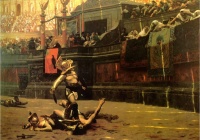Secutor
From The Art and Popular Culture Encyclopedia

|
Related e |
|
Featured: |
A Secutor (pl. Secutores) was a class of gladiator in ancient Rome.
Thought to have originated around 50 AD, the Secutor ("Follower", from sequor "I follow, come or go after") was armed similarly to the Murmillo gladiator, and like the Murmillo, was protected by heavy armour. A Secutor usually carried a short sword, a gladius, or a dagger. The Secutor was specially trained to fight a Retiarius, a type of lightly armoured gladiator armed with a trident and net.
The very distinctive helmet of the Secutor had only two small eye-holes, in order to prevent a Retiarius's trident from being thrust through the face, as well as a rounded top, so as not to get caught in a net. The flanges protecting his neck were smooth and shaped like fish fins for this purpose. Because of the weight and lack of space in the helmet, the secutor had to win quickly, lest he fall to exhaustion or faint due to breath constrictions.
The secutor wore a loincloth, and a wide belt (much like that of the retiarius). On his right arm, he wore a manica (a heavy linen or metal wrapping tied with leather thongs), and on his left leg, he wore an ocrea (a greave made of boiled leather or metal). He also carried a scutum (a curved rectangular shield) to protect himself.

